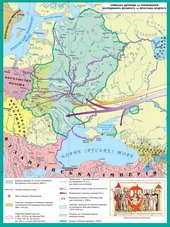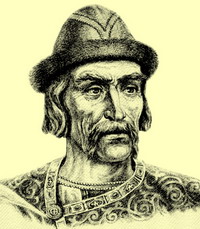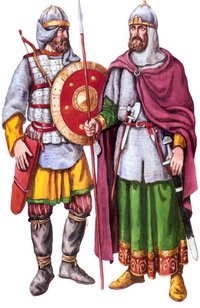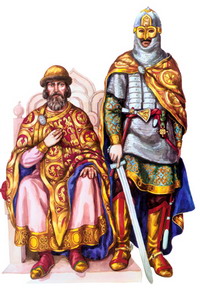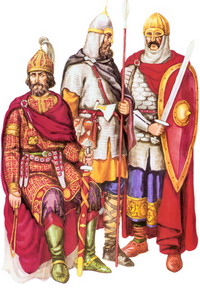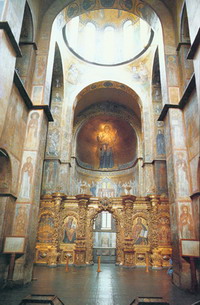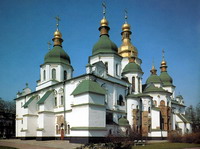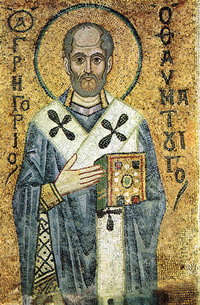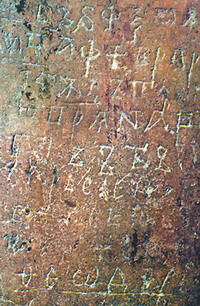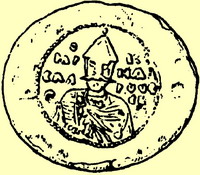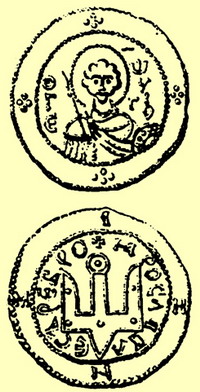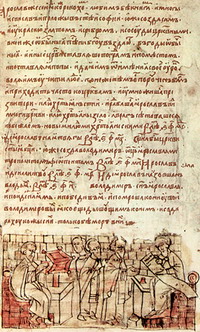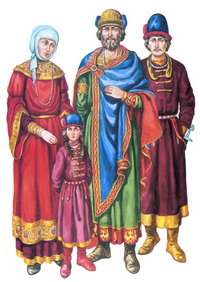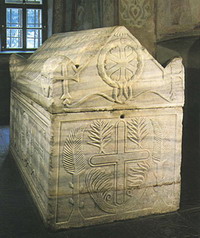Kiev State under Yaroslav the Wise
Plan presentation
- power struggle between the sons of Vladimir Svyatoslavich. Claims Yaroslav Vladimirovich of Great-table.
- affirm Vladimirovich Yaroslav in Kiev.
- Domestic policy Yaroslav.
- foreign policy measures Yaroslav the Wise.
Chronology of events
|
1019 |
Battle of Yaroslav Sviatopluk on the river Alta |
|
1019-1054 biennium |
reign of Yaroslav the Wise in Kiev |
|
1017-1037 he |
construction of Saint Sophia Cathedral, the fortifications around the "city of Yaroslav, construction of the Golden Gate in Kiev |
|
1048 |
Embassy of French King Henri I Capet of France to Yaroslav. The marriage of Anne daughter of Prince French king |
|
1051 |
purpose Kiev Metropolitan Hilarion, the first in this post Rusyches. Establishment of Cave Monastery |
basic concepts and terms
«Russkaya Pravda» - collection, or arch, Rus laws, which consisted of few generations. The oldest parts created during Yaroslav the Wise, a separate part of the article concluded Yaroslaviv sons - Charter Yaroslavychi. In "Ruska Pravda" includes articles and later times. Collection in force on the territory of Ukraine, Belarus, Lithuania and Russia for several centuries, became the basis for the development of law and justice.
Gospel (from the Greek. Tidings) - one of the most important parts of the New Testament, consisting of the first four books written by evangelists Matthew, Mark, Luke , John. It describes the earthly life of the Lord, the Son of God, Jesus Christ: His teaching, miracles, religious suffering, death, resurrection and ascension into heaven.
Graffiti - inscriptions and drawings scratched on walls and architectural details of ancient buildings, containers and other items that are found during archaeological sites.
Mosaic - Appliances decorating walls and floors, which cement-based in a certain order, the small pieces of colored stone or glass - smalt.
Cathedral - home or a large church in the city, the main church of the monastery. Cathedral Church pravoslvniy called large meeting of representatives of clergy and laity to discuss important issues and are made binding decisions.
Patriarch - the highest title of the cleric in the Orthodox churches.
Metropolitan - rank second, after the patriarch. Standing at the head of the church and the territorial unit - the metropolis.
Deacon - assistant priest in the celebration of church services, lower spiritual rank.
Monk (chenets ) - a believer who repudiated conventional secular (worldly) life in favor of serving God.
Monasty p - a complex of buildings intended for religious accommodation, sending their religious rites, training, etc..
Personality
 YAROSLAV WISE (c. 978 - 1054) - Grand Duke of Kyiv (1019 - 1954). Son Vladimir Svyatoslavich and Polotsk Princess Rogned Rohvolodivny . Prince Yaroslav the Wise lucky, say researchers, is much more than all his predecessors and even the many successors. He lived a long life and died at the height of her fame and power. To this day preserved marble sarcophagus with the remains of it, to explore which scientists not only restored the appearance of Prince, but also found to have suffered a disease. The life of Yaroslav and his family tell the Russians are not the only records, but many a foreign source. On the walls of Saint Sophia Cathedral in Kiev - the temple, built by Yaroslav the Wise, the oldest fragments of images, among which are some of the most Yaroslav and his family. After many campaigns and battles, winning in the confrontation with the brothers right to rule in Kiev, Yaroslav avoid accusations of cruelty and guile, and remained in the memory of posterity peaceful, quiet and prudent prince, who showed enthusiasm for books, often reading them day and night, for which he was honored by the name of Wise.
YAROSLAV WISE (c. 978 - 1054) - Grand Duke of Kyiv (1019 - 1954). Son Vladimir Svyatoslavich and Polotsk Princess Rogned Rohvolodivny . Prince Yaroslav the Wise lucky, say researchers, is much more than all his predecessors and even the many successors. He lived a long life and died at the height of her fame and power. To this day preserved marble sarcophagus with the remains of it, to explore which scientists not only restored the appearance of Prince, but also found to have suffered a disease. The life of Yaroslav and his family tell the Russians are not the only records, but many a foreign source. On the walls of Saint Sophia Cathedral in Kiev - the temple, built by Yaroslav the Wise, the oldest fragments of images, among which are some of the most Yaroslav and his family. After many campaigns and battles, winning in the confrontation with the brothers right to rule in Kiev, Yaroslav avoid accusations of cruelty and guile, and remained in the memory of posterity peaceful, quiet and prudent prince, who showed enthusiasm for books, often reading them day and night, for which he was honored by the name of Wise.
1. The power struggle between the children of Vladimir Svyatoslavich
Claims Yaroslav Vladimirovich of Great-table
-
 From Chronicle learn that first got Jaroslav possession from his father Rostov.
From Chronicle learn that first got Jaroslav possession from his father Rostov.
Vladimir - soon gave him a prestigious portion - Novgorod. It happened, record shows, after the death of Novgorod prince Volodymyr older son Vysheslav.
- reign in Novgorod was tarnished by the complication of relations with his father. Chronicler told that because of the unwillingness of Yaroslav Kiev annual pay tribute between father and son nearly come to war. Actually, Vladimir's wife was setting up to campaign against Novgorod, but he died unexpectedly rozhvorivsya.
Death of Volodymyr the Great destroyed a set in the state system, four years lyhomanylo country, ran mizhknyazivski intestine wars for power in Kiev, during which the arrested chairman Volodymyr's four sons, destined to become the winner Yaroslav.
fight for Kyiv
entire blame for the bloody intestine wars between the Russians Vladimirovich written monument lay on Sviatopolk - elder living at the time the children of Vladimir. It Svyatopolk on his father's death in 1015 became established in Kyiv.
-
 The first victims of insidious plan became the youngest V. - Boris and Gleb. A little later their fate is also shared Svyatoslav.
The first victims of insidious plan became the youngest V. - Boris and Gleb. A little later their fate is also shared Svyatoslav.
- shed innocent blood pokvapyla Yaroslav to action. In Novgorod, receiving the news of his father's death and lawlessness Sviatopolk he ordered druzhinnik lashtuvatysya to hike.
- first armed confrontation with Yaroslav Sviatopluk was, presumably, researchers in the early winter of 1015 under Lyubech. Fierce battle ended in utter defeat Sviatopolk troops.
- loser prince retreated from the battlefield, so Jaroslav freely entered to Kyiv.
- After the defeat in 1015 Svyatopolk fled to Poland, under shelter of King Boleslaw the Brave, which he dovodyvsya test. Boleslaw Svyatopolk persuaded to lead the army in the land of Rus. Trip occurred in 1018
- This time the battle between Jaroslav Sviatopluk and held at the university, near the city of Volyn.
- won the Boleslaw the Brave Warriors, Jaroslav left back to Kyiv and Novgorod.
- Meanwhile, August 4, 1018 to the capital of Russia joined the army and Sviatopolk Boleslav.
- Chronicle reports that they are treated very roughly, feeling conquerors.
- did not like Kiev. Residents of the town rebelled.
- Boleslav, taking a lot of property and robbed many of the captives, hastened to leave Kyiv.
- Svyatopolk, losing the last commitment of Kiev, the threat of a new campaign Yaroslav fled from the city to Pechenegs.
Jaroslav - properly used bitter experience of defeat and gathered for a decisive battle with Svyatoslav "many warriors.
- In 1019 on the River Alta Jaroslav Sviatopolk broken army, forcing Cain shamefully run away - somewhere in exile forever lost it should be.
deceased brothers Boris and Gleb were soon joined the ranks of the saints: they are destined to become the first saints canonized Ruthenian church. And just like them and we poshanovuyemo. Svyatopolk was condemned by fratricide Cain as the Old Testament - history still remembers him as Sviatopolk Damned. And the glory of Yaroslav the Wise earned a fair ruler, who ended the intestine wars and first started to commemorate the victims of fratricidal war, having found their remains and buried with honors in Vyshgorod.
2. Consolidation in Kiev Yaroslav V.
During the year
1019 chronicler занотував: «sat Yaroslav in Kiev, obter sweat from his wife, showing a great victory and the labor».
-

 Soon after the establishment in Kiev, Yaroslav had to leave the capital and go north in the earth to stop an attack on Novgorod Polotsk prince Yaroslav nephew, Bryachyslava.
Soon after the establishment in Kiev, Yaroslav had to leave the capital and go north in the earth to stop an attack on Novgorod Polotsk prince Yaroslav nephew, Bryachyslava.
- Once that conflict was settled as a new force came - with Tmutarakansky prince Mstislav, who in 1023 suddenly brought his wife to Kyiv. Mstislav dovodyvsya Yaroslav's brother.
In previous - intestine wars he, according to the chronicler, did not participate. As for his claims to Kyiv, they gained an unexpected development.
- The fact that Mstislav won the battle with Yaroslav, but from Kyiv refused to acknowledged the elder brother.
- Year 1026 to agree to a peace agreement, under which the Russians divided the land along the Dnieper: right-bank land belonged to Kyiv Yaroslav, and the left bank of Chernigov - Mstislav. This order reign lasted 10 years - the death of Mstislav.
therefore only from 1036 Jaroslav yedynovladnym became ruler of Kievan Rus.
3. Domestic Policy
Preserving the territorial integrity and unity of the Rus
Jaroslav
-
 back under its authority Chervensk city reclaimed during the prince's intestine wars Boles
back under its authority Chervensk city reclaimed during the prince's intestine wars Boles - also went north to the Baltic Sea coast, where land laid Peipus Yuryev city.
- not leaving the building, started by his father, on the northern border of Rus.
- finally overcame Pechenegs.
news of the last, winning for Yaroslav battle against Pechenegs that occurred in the walls of Kyiv, published in 1036, however, modern historians refer to it in 1017 to commemorate the victory Jaroslav ordered the construction of magnificent temple town of Battle - St. Sophia Cathedral .
Building Kyiv
About Kyiv - times of Yaroslav Mudry said that he was an ornament and Russia rival of Constantinople itself.
- Area «city of Yaroslav» compared to the stronghold by Vladimir increased sevenfold. Another powerful and higher walls and steel shaft.
-
 Highlight of Kyiv were Golden Gate - a ceremonial entrance to the city - from the Gate Church of the Annunciation, Sophia Cathedral Church of St. George, built in honor of the patron Saint of the Grand Prince [Yaroslav church name - George (Yuri)] and the Church of St. Irene .
Highlight of Kyiv were Golden Gate - a ceremonial entrance to the city - from the Gate Church of the Annunciation, Sophia Cathedral Church of St. George, built in honor of the patron Saint of the Grand Prince [Yaroslav church name - George (Yuri)] and the Church of St. Irene .
-
 The real pearl of Old Rus architecture, the greatest building in Kyiv during the time of Yaroslav the Wise was Cathedral of St. Sophia .
The real pearl of Old Rus architecture, the greatest building in Kyiv during the time of Yaroslav the Wise was Cathedral of St. Sophia .
- It was great, crowned with 13 domes has a stone church, surrounded on three sides by two rows of open galleries.
- from the West to the cathedral was added two towers with wide spiral staircase to the church choirs.
- Even more than the external grandeur surprised interior decoration of the house. Most impressed the wall image - Murals and mosaics, among which many were dedicated to the founder of the temple - Prince Yaroslav.
-
 Kiev Sofia symbolized the combination of the divine and the beginning of the government. Cathedral at the same time been a major, metropolitan temple of Russia and the place of nayurochystishyh state ceremonies - climbing the Great-table, taking his foreign ambassadors and others.
Kiev Sofia symbolized the combination of the divine and the beginning of the government. Cathedral at the same time been a major, metropolitan temple of Russia and the place of nayurochystishyh state ceremonies - climbing the Great-table, taking his foreign ambassadors and others.




Managing laws
-
 Establishing domestic life was impossible without laws ordering.
Establishing domestic life was impossible without laws ordering.
- to steps in this direction once resorted Prince Vladimir.
- and honor a true reformer of laws belongs to Yaroslav - because he was the first signed written Rus collection laws .
That document - researchers called «true Yaroslav», or oldest true.
- It consisted of 18 articles, which launched the famous collection of laws - «Rus truth».
-

 The articles discussed Jaroslav
The articles discussed Jaroslav
- of punishment for murder,
- beating to blood or bruises,
- committed by mutilation,
- pulling the beard and mustache,
- riding a strange horse,
- damage to property,
- harboring alien serf etc..
-
 Punishment usually involved a cash payment, though still kept the right to family vendetta.
Punishment usually involved a cash payment, though still kept the right to family vendetta.
-

 Cash benefits paid to or for the benefit of the Prince - they were called "faiths", or in favor of the victim or his relatives - holovschyny. Corporal punishment should apply only to serf for beating a free man. Among the measures of punishment was not a death penalty.
Cash benefits paid to or for the benefit of the Prince - they were called "faiths", or in favor of the victim or his relatives - holovschyny. Corporal punishment should apply only to serf for beating a free man. Among the measures of punishment was not a death penalty.
Support Christian Church
Yaroslav the Wise
strongly promoted the establishment and spread in the Ruthenian lands Christian teaching.
- He not only supervised the construction of churches, but maintained the authority of the prince's power is not strong church organization.
- Supported by Yaroslav the Wise, the 1051 was elected the first Metropolitan of Rus - it was Hilarion.
- in 1051, testified chronicler, a monk Antony began Caves Monastery - in the near future leading center of church and cultural and educational life.
Educational activities of Yaroslav the Wise
-
 To ensure that need Ruthenian churches in the books, set up in Kiev, Yaroslav at St. Sophia Cathedral scriptor-workshop to rewrite books.
To ensure that need Ruthenian churches in the books, set up in Kiev, Yaroslav at St. Sophia Cathedral scriptor-workshop to rewrite books.
- There is still taught literacy and basic knowledge of oznayomlyuvaly children from wealthy families.
- The cathedral was acting kind of library that can consist of up to 1000 volumes of rare books. In Sofia the library worked with Old Rus scribes - priests, theologians, chroniclers, ancient Russians writers and scientists.
- There were schools and at other churches and monasteries. The evidence of the spread of literacy among different segments of that time Kyiv is graffiti .
4. External events Yaroslav the Wise
-
 In foreign policy, used every opportunity diplomacy, among which an important place occupied mizhdynastychni marriages. No wonder Yaroslav the Wise called father in Europe.
In foreign policy, used every opportunity diplomacy, among which an important place occupied mizhdynastychni marriages. No wonder Yaroslav the Wise called father in Europe.
- the scale of foreign policy and about authority Yaroslav him as ruler of the fact that all his children, he married advantageously. Porodychavshys noblest of the European family, a wise prince of Kievan Rus linked with Europe blood ties.
- traditionally close relationship developed between Kievan Rus and Byzantium.
However - friendly allied relations of Byzantium and Russia have undergone tests after consolidation of the imperial throne of Constantine IX Monomakh in 1042
- He started his activity with that removed from the governance proxies all previous emperors.
- disgraced the band got the Russians and people. Relations between Russia and Byzantium particularly heightened in 1043
- direct drive to the Ruthenian Byzantine conflict was a quarrel between the market of Constantinople by the Greeks and Ruthenians. During her Ruthenian merchants have suffered great losses, and one notable Rusyches killed.
- Yaroslav the Wise, of course, could not respond to antyruski of Constantine IX. Was collected a large army. Expedition to Constantinople led son Vladimir and Yaroslav Vyshata governor.
- Ruski ships appeared before Constantinople in June 1043, however the war did not come.
- Byzantium agreed to concessions. A new peace treaty was sealed with marriage Yaroslav son and daughter of Vsevolod Monomakh Mary.
- And soon, in 1051, relations between Kyiv and Constantinople worsened again. The reason for dissatisfaction with the Constantinople government was ordained Metropolitan of Kiev. But even then the conflict settled peacefully.
- maintained regular contact since Kievan Rus Yaroslav and Hermanskoyu Empire . Contemporary sources include an Ruthenian embassy in 1040 to Henry III.
- For three years from messengers "Ruthenian King" once again visited Germanic ruler: they allegedly offered him presents chronicler, the wife of daughter of the prince.
- and Henry had already married, so the proposal Rus not.
- Yet around the middle of XI century. several marriages between princely family of Yaroslav and Germanic powers were concluded.
- particularly lively relationship was Kievan Rus to Poland.
- evidenced neighborly relations have become marital relationships. Polish Prince Casimir married sister Mary Dobronihoyu Yaroslav, and his sister Gertrude, married Olisava Izyaslav Yaroslavych.
- close relationship with Russia supported the Scandinavian countries.
Especially - stronger ties of Russia and Sweden, contributed to why the marriage of Yaroslav Inhiherdoyu.
- Good relations between Russia tied with Norway.
- written sources confirm active foreign relations of Russia and Hungary. As evidenced by those relationships were dynastic marriages of members of the royal family and the Kiev Grand Arpad.
- late 40-ies Article XI. Russia established friendly relations with France, with Kapetinhiv dynasty.
-
 Were adjusted by marriage of Henry and Anna Yaroslavna in 1049
Were adjusted by marriage of Henry and Anna Yaroslavna in 1049
Interstate Relations Kievan Rus demonstrate great authority of the state of Yaroslav the Wise in Europe.

 English
English
 YAROSLAV WISE (c. 978 - 1054) - Grand Duke of Kyiv (1019 - 1954). Son Vladimir Svyatoslavich and Polotsk Princess Rogned Rohvolodivny . Prince Yaroslav the Wise lucky, say researchers, is much more than all his predecessors and even the many successors. He lived a long life and died at the height of her fame and power. To this day preserved marble sarcophagus with the remains of it, to explore which scientists not only restored the appearance of Prince, but also found to have suffered a disease. The life of Yaroslav and his family tell the Russians are not the only records, but many a foreign source. On the walls of Saint Sophia Cathedral in Kiev - the temple, built by Yaroslav the Wise, the oldest fragments of images, among which are some of the most Yaroslav and his family. After many campaigns and battles, winning in the confrontation with the brothers right to rule in Kiev, Yaroslav avoid accusations of cruelty and guile, and remained in the memory of posterity peaceful, quiet and prudent prince, who showed enthusiasm for books, often reading them day and night, for which he was honored by the name of Wise.
YAROSLAV WISE (c. 978 - 1054) - Grand Duke of Kyiv (1019 - 1954). Son Vladimir Svyatoslavich and Polotsk Princess Rogned Rohvolodivny . Prince Yaroslav the Wise lucky, say researchers, is much more than all his predecessors and even the many successors. He lived a long life and died at the height of her fame and power. To this day preserved marble sarcophagus with the remains of it, to explore which scientists not only restored the appearance of Prince, but also found to have suffered a disease. The life of Yaroslav and his family tell the Russians are not the only records, but many a foreign source. On the walls of Saint Sophia Cathedral in Kiev - the temple, built by Yaroslav the Wise, the oldest fragments of images, among which are some of the most Yaroslav and his family. After many campaigns and battles, winning in the confrontation with the brothers right to rule in Kiev, Yaroslav avoid accusations of cruelty and guile, and remained in the memory of posterity peaceful, quiet and prudent prince, who showed enthusiasm for books, often reading them day and night, for which he was honored by the name of Wise. From Chronicle learn that first got Jaroslav possession from his father Rostov.
From Chronicle learn that first got Jaroslav possession from his father Rostov. 
 The first victims of insidious plan became the youngest V. - Boris and Gleb. A little later their fate is also shared Svyatoslav.
The first victims of insidious plan became the youngest V. - Boris and Gleb. A little later their fate is also shared Svyatoslav. 
 Soon after the establishment in Kiev, Yaroslav had to leave the capital and go north in the earth to stop an attack on Novgorod Polotsk prince Yaroslav nephew, Bryachyslava.
Soon after the establishment in Kiev, Yaroslav had to leave the capital and go north in the earth to stop an attack on Novgorod Polotsk prince Yaroslav nephew, Bryachyslava.  back under its authority Chervensk city reclaimed during the prince's intestine wars Boles
back under its authority Chervensk city reclaimed during the prince's intestine wars Boles Highlight of Kyiv were Golden Gate - a ceremonial entrance to the city - from the Gate Church of the Annunciation, Sophia Cathedral Church of St. George, built in honor of the patron Saint of the Grand Prince [Yaroslav church name - George (Yuri)] and the Church of St. Irene .
Highlight of Kyiv were Golden Gate - a ceremonial entrance to the city - from the Gate Church of the Annunciation, Sophia Cathedral Church of St. George, built in honor of the patron Saint of the Grand Prince [Yaroslav church name - George (Yuri)] and the Church of St. Irene .  The real pearl of Old Rus architecture, the greatest building in Kyiv during the time of Yaroslav the Wise was Cathedral of St. Sophia .
The real pearl of Old Rus architecture, the greatest building in Kyiv during the time of Yaroslav the Wise was Cathedral of St. Sophia .  Kiev Sofia symbolized the combination of the divine and the beginning of the government. Cathedral at the same time been a major, metropolitan temple of Russia and the place of nayurochystishyh state ceremonies - climbing the Great-table, taking his foreign ambassadors and others.
Kiev Sofia symbolized the combination of the divine and the beginning of the government. Cathedral at the same time been a major, metropolitan temple of Russia and the place of nayurochystishyh state ceremonies - climbing the Great-table, taking his foreign ambassadors and others. 



 Establishing domestic life was impossible without laws ordering.
Establishing domestic life was impossible without laws ordering.  The articles discussed Jaroslav
The articles discussed Jaroslav  Cash benefits paid to or for the benefit of the Prince - they were called "faiths", or in favor of the victim or his relatives - holovschyny. Corporal punishment should apply only to serf for beating a free man. Among the measures of punishment was not a death penalty.
Cash benefits paid to or for the benefit of the Prince - they were called "faiths", or in favor of the victim or his relatives - holovschyny. Corporal punishment should apply only to serf for beating a free man. Among the measures of punishment was not a death penalty.  To ensure that need Ruthenian churches in the books, set up in Kiev, Yaroslav at St. Sophia Cathedral scriptor-workshop to rewrite books.
To ensure that need Ruthenian churches in the books, set up in Kiev, Yaroslav at St. Sophia Cathedral scriptor-workshop to rewrite books.  In foreign policy, used every opportunity diplomacy, among which an important place occupied mizhdynastychni marriages. No wonder Yaroslav the Wise called father in Europe.
In foreign policy, used every opportunity diplomacy, among which an important place occupied mizhdynastychni marriages. No wonder Yaroslav the Wise called father in Europe.  Were adjusted by marriage of Henry and Anna Yaroslavna in 1049
Were adjusted by marriage of Henry and Anna Yaroslavna in 1049 
